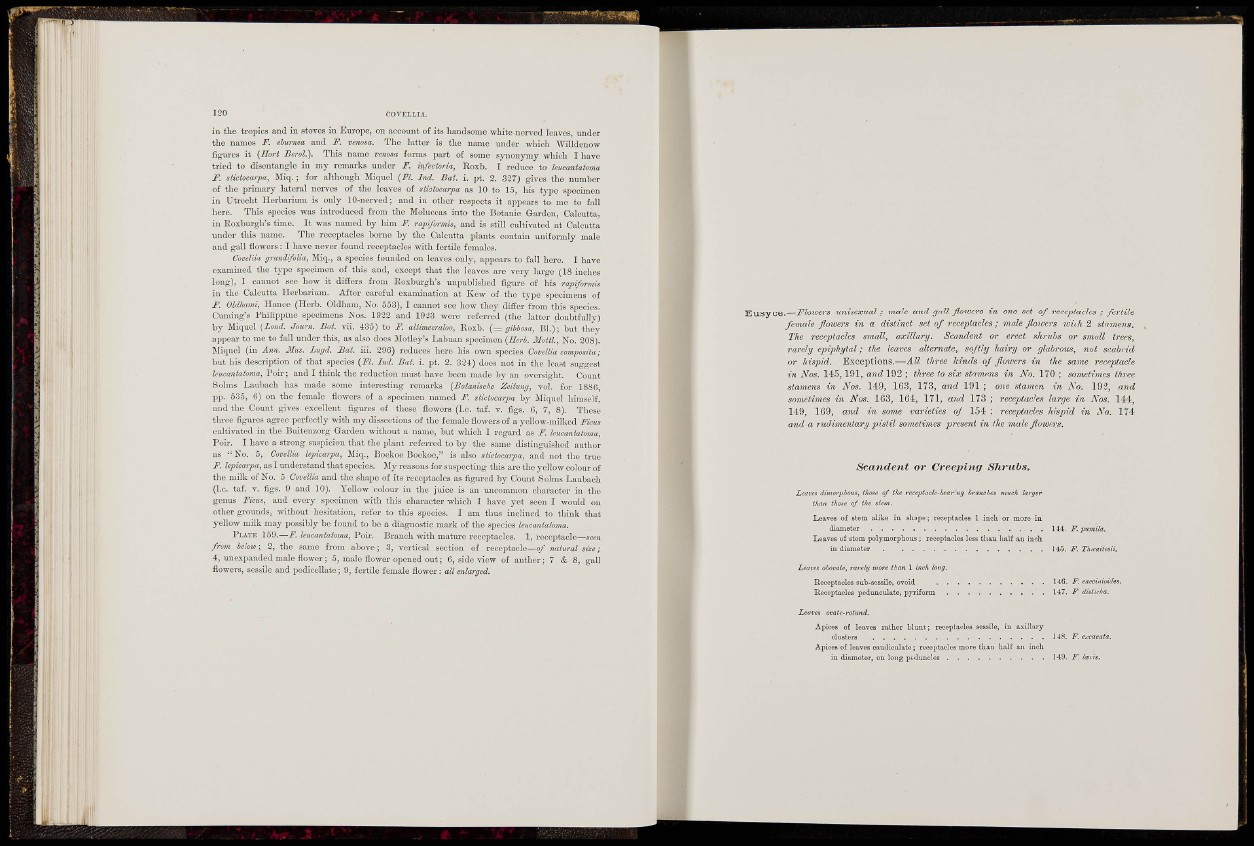
in the tropics and. in stoves in Europe, on account of its handsome white-nerved leaves, under
t h e names F. eburnea and J', venosa. The latter is the name under which Willdenow
iigui-es it {Jlort Bevol). This name venosa forms pai-t of some synonymy which I have
t r i e d to disentangle in my remarks under F. infectoria, Roxb. I reduce to Icucantatoma
F. stictocarpa, Miq. ; for although Miquel {Fl. Ind. Bat. i. pt. 2. 327) gives the number
of the primary lateral nerves of the leaves of stictocarpa as 10 to 15, his t}T?e specimen
in Utrecht Herbarium is only 10-nervcd; and in other respects it appears to me to fall
here. This species was introduced from the Moluccas into the Botanic Gai-den, Calcutta,
in Roxbau-gh's time. It was named by him F. rapiformis, and is still cultivated at Calcutta
under this name. The receptacles borne by the Calcutta plants contain unifoi-mly male
and g-all flowers : I have never found receptacles with fertile females.
Covelivt grandifoUa, Miq,, a species founded on leaves only, appears to fall here. I have
examined the t}'-pe specimen of this and, except that the leaves arc very lai-ge (18 inclies
long), I cannot see how it differs from Roxburgh's unpublished fìg-m-e of his rapiformis
in the Calcutta Herbarium. After careful examination at Kew of the type specimens of
F. Oldliami, Hance (Herb. Oldliam, No. 553), I cannot see how they differ f rom this species.
Cuming's Philippine specimens Nos. 1922 and 1923 were referred (the latter doubtfully)
b y Miquel [Lond. Journ. Bot. vii. 435) to F. altivieeraloo, Roxb. {= yibhosa, Bl.); but they
appeal- to me to fall under this, as also does Motley's Labuan specimen {Herb. Motti, No. 208).
Miquel (in Ann. Mus. Lugd. Bat. iii. 296) reduces here his own species Covellia composita;
but his description of that species {Fl. Ind. Bat. i. pt. 2. 324) does not in the least suggest
leucantatoma, Poh-; and I think the reduction must have been made by an oversight. Count
Solms Laubach has made some intei-esting remai'ks {Botanische Zeitung, vol. for 1886,
pp. 535, G) on the female flowers of a specmicn named F. stictocavpn by Miquel himself,
and the Count gives excellent figures of these flowers (I.e. taf. v. figs. G, 7, 8). These
three figures agree perfectly with m y dissections of the female flowers of a yellow-milked Ficus
cultivated in the Buitenzorg Garden without a name, but which I regard as F. Icucantatoma,
Poir. I have a strong suspicion that the plant referred to b y the same distinguislied author
as "No. 5, Covellia lepicarpa, Miq., Boekoc Boekoe," is also stictocarpa, and not the true
F. lepicarpa, as I understand that species. My reasons for suspect ing this are the yel low colom- of
t h e milk of No. 5 Covellia and the shape of its receptacles as figured by Count Solms Laubach
(I.e. taf. V. figs. 9 and 10). Yellow colour in the juice is an uncommon chai-acter in the
genus Ficus, aud every specimen with this character which I have yet seen I would on
other gi-ounds, without hesitation, refer to this species. I am thus inclined to think that
yellow milk may possibly be found to be a diagnostic mark of the species leucantatoma.
PLATE 159.—F. leucantatoma, Poii-. Branch with matm-e receptacles. 1, receptacle—seen
from leloto] 2, the same from above; 3, vertical section of receptacle—o/ natural size;
4, uncxi)anded male flower; 5, male flower opened out ; 6, side view of anther; 7 & 8, gall
flowers, sessile and pedicellate ; 9, fertile femal e flower : all enlarged.
Eusyce.—-^'^oit'-ers unisexml; male and gall flowers in one set of receptacles ; fertile
female flowers in a distinct set of receptacles; male flowers louh 2 stamens.
The receptacles small, axillary. Scandent or erect shrtibs or smoll trees,
rarely epiphytal; the leaves alternate, softly hairy or glabrous, not scab rid
or hispid. Exceptions.—All three kinds of flowers in the same receptacle
in Nos. 145,191, and 192 ; three to six stamms in No. 170 ; sometimes three
staviens in Nos. 149, 163, 173, and 191 ; one stamen in No. 192, and
sometimes in Nos. 163, 164, 171, and 173 ; receptacles large in Nos. 144,
149, 169, and in some varieties of 154 : receptacles hispid in No. 174
and a rudimentary pistil sometimes present in the male flowers.
Scandent or Creeping Shrubs.
Leaves dimorphous, those of the receptacle-hcar.ng branohea much larger
than those of the stem.
Leaves of stem alike in shnpe; receptacles 1 inch or more in
diameter 144. F. pumila.
Leaves of stem polymorphous; receptacles less than half an iuch
in diameter 145. Thwaitesit.
Leaves obotate, rare/t/ more than 1 inch hng.
Receptacles sub-sessile, ovoid 146. F. cacci'noiJes.
Beceptacles pedunculate, pyriform 147. F disticha.
Leaves ovate-rotund.
Apices of leaves rather blunt; receptacles sessile, in asilLiry
clusters 148. F. e^cavata.
Apices of leaves caudiculate; receptacIcs more thau half au inch
in diameter, on long p&duncles 149. F. l<Bcis.